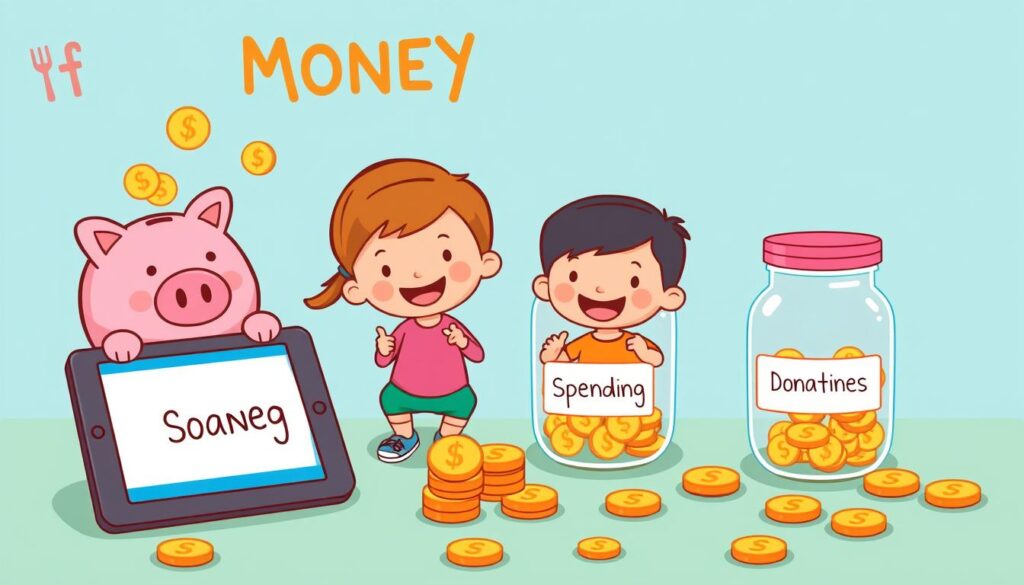As a parent, you want the best for your child, including teaching them about money. You might wonder how and when to start. Teaching kids about money is key for their financial future. Start early with basic lessons like saving and spending wisely.
Teaching your child about money can be a challenge. But with the right approach, you can instill lasting money habits. By teaching them, you empower them to make smart financial choices. This sets them up for financial success in the long run.
Key Takeaways
- Start teaching your child about money early to help them develop good habits
- Introduce basic money lessons for kids, such as saving and spending wisely
- Consider using allowances to teach your child about money management
- Help your child understand the difference between needs and wants
- Encourage your child to make informed financial decisions
- Be a good role model and demonstrate responsible money management yourself
- Make learning about money fun and engaging for your child
Understanding the Importance of Financial Education for Children
As a parent, you have a big role in your child’s financial future. Teaching them about money is key. It helps them learn good habits and make smart money choices. This education can greatly impact their financial success later on.
Starting early with money management for kids can prevent financial mistakes. Begin with basic ideas like saving and spending. Then, move on to more complex topics like budgeting and investing.
- Developing healthy financial habits
- Improving financial literacy
- Enhancing decision-making skills
- Building a strong foundation for long-term financial success
By focusing on financial education for children and teaching kids about money, you empower them. They’ll be able to make smart money choices. This sets them up for a bright financial future.
When to Start Teaching Kids About Money
As a parent, you might wonder when to start teaching kids about money. The answer is simple: it’s never too early. You can start talking to your children about money from a young age. This lays the groundwork for a healthy relationship with money.
By starting early, you help your kids develop good money habits. They’ll make informed financial decisions as they grow. Teaching kids about money is a vital skill that benefits them in the long run.
You can start with simple lessons, like the value of saving and budgeting. As your child gets older, you can introduce more complex topics. This includes investing and managing credit. By talking about money every day, your child will understand personal finance well.

By covering these topics, your child will grasp money management well. Remember, start early and be consistent in teaching kids about money.
Creating Age-Appropriate Money Lessons
As a parent, you want the best for your child, including teaching them about money. It’s important to make money lessons for kids fit their age. Start with simple ideas like counting and saving for your preschooler. When they get to elementary school, they can learn more, like making change and understanding money’s value.
Making teaching kids about savings fun is key. Use a clear jar or piggy bank to show them their savings. As they grow, introduce topics like investing and credit. This way, you help them build a strong financial foundation.

- For preschoolers (ages 3-5): Focus on basic money concepts, such as counting and saving.
- For elementary school students (ages 6-11): Introduce more complex money skills, such as budgeting and making change.
- For teenagers (ages 12-18): Teach more advanced financial topics, such as investing and credit management.
By following these tips, you can help your child develop good money habits and a strong foundation in financial literacy.
How to Teach Your Child About Money: Allowances, Savings, and Spending Fundamentals
Teaching kids about savings starts with the basics. Giving your child a regular allowance helps them learn budgeting and making financial choices. Encourage them to save some of their allowances for children and understand the value of smart spending.
To help your child develop good money habits, consider these tips:
- Set clear expectations for how their allowance should be used
- Encourage them to save a portion of their allowance in a piggy bank or savings account
- Teach them about the importance of teaching kids about savings and spending wisely
By following these tips and giving your child a regular allowance, you can lay a strong financial foundation. Be patient and supportive as they learn how to teach your child about money and form their own financial habits.

| Age Group | Allowance Amount | Savings Goal |
|---|---|---|
| Preschoolers (3-5) | $5-10 per week | Save 10-20% of allowance |
| Elementary School (6-11) | $10-20 per week | Save 20-30% of allowance |
| Teenagers (12-18) | $20-50 per week | Save 30-50% of allowance |
Setting Up an Effective Allowance System
Teaching kids about money starts with a good allowance system. You need to figure out how much to give, when to give it, and if it should be for chores or just for being a kid. This helps your child learn to manage money well and feel good about it.
Allowances are a key part of teaching kids about money. They help your child learn to budget, save, and make smart money choices. This skill is vital for their future.

Determining the Right Amount
Figuring out the right amount is important. Think about your child’s age, needs, and money goals. Also, consider the cost of living in your area and what your child might want to buy. A fair allowance helps your child learn to spend wisely.
Establishing Payment Schedules
Having a regular payment schedule is key. It helps your child understand budgeting and making money choices. You can pay weekly, bi-weekly, or monthly, depending on your family’s needs. A schedule teaches your child to be responsible with money.
Teaching the Value of Savings
As a parent, you have a big role in your child’s financial future. Teaching kids about savings is key to their financial education. By encouraging your child to save, you teach them important money management for kids skills. This habit will help them make smart choices about kids and spending habits later on.
Start by helping your child set financial goals, like saving for a toy or experience. This gives them a reason to save. You might also open a savings account for them to put their allowance in each month.
- Encourage your child to save a fixed amount regularly
- Help them set short-term and long-term financial goals
- Teach them to track their expenses and make smart financial decisions
By teaching your child about savings, you give them a strong financial foundation. This will help them deal with money management for kids and make smart choices about kids and spending habits. Show them the value of saving by doing it yourself and making it a family effort.

As your child gets older, they’ll face many financial challenges. By teaching them the value of savings and giving them money management for kids skills, you prepare them to handle these challenges. This will help them achieve financial stability.
| Age Group | Savings Goal | Monthly Savings |
|---|---|---|
| 6-12 years | Short-term goals (e.g., toys, games) | $10-$20 |
| 13-18 years | Long-term goals (e.g., education, car) | $50-$100 |
Smart Spending Habits for Kids
Teaching your kids about money is key for their financial future. It’s important to help them learn to spend wisely. Start by explaining the difference between needs and wants and how to choose wisely.
It’s vital for kids to think carefully about what they buy. Teach them to check if something is worth the price and compare costs. This helps them avoid buying things on impulse.
The Difference Between Needs and Wants
Helping kids understand needs versus wants is a big part of teaching them about money. Needs are things like food, clothes, and a home. Wants are things like toys or treats. Knowing this helps kids make better choices and develop good spending habits.

Making Informed Purchase Decisions
To teach kids about money, encourage them to think about a few things before buying:
- Do I really need this item?
- Can I afford it?
- Are there any alternative options?
By thinking about these questions, kids can learn to spend wisely and make smart choices.
Teaching kids about money takes time, patience, and positive support. Start early and be a good example. This way, your kids will grow up with good spending habits and a strong understanding of money.
Digital Money Management Tools for Children
As a parent, you want to give your child the best start in life. This includes teaching them about money. Today, there are many digital tools to help with this. These tools make learning about money fun and interactive.
Popular tools include kid-friendly banking apps, virtual piggy banks, and online games. They help kids learn good money habits. For instance, banking apps let kids track their spending and savings. Virtual piggy banks help them set and reach financial goals.
Here are some benefits of using digital money management tools for children:
- Interactive and engaging way to learn about money management
- Helps kids develop good money habits and a strong foundation in financial literacy
- Provides a safe and secure way for children to manage their money

When choosing a digital money management tool for your child, consider these factors:
- Ease of use: Is the tool easy for your child to use and understand?
- Features: Does the tool offer the features you need, such as tracking spending and savings, and setting financial goals?
- Security: Is the tool secure and safe for your child to use?
Using digital tools can help your child develop good money habits. It sets them up for success in the future. Always supervise and guide your child as they use these tools. Provide them with a complete financial education that includes money management for kids, teaching kids about money, and financial education for children.
Real-World Money Learning Opportunities
As a parent, you have a big role in teaching kids about money. You can do this by giving them real-world lessons. This means involving them in everyday money tasks, like grocery shopping or paying bills.
By doing this, you help your kids learn about money lessons for kids in a hands-on way. For example, you can take them to the store. Let them help you compare prices and make smart choices. This teaches them about money’s value and boosts their critical thinking.
Another great way is to use daily life to teach financial education for children. Explain why saving for big goals, like college or a car, is important. Show them how saving a part of their allowance can help reach these goals.
- Encourage them to start a small business, like dog walking or lawn care. This teaches them about entrepreneurship and managing money.
- Help them make a budget and track their spending. This shows the value of saving and spending wisely.
- Talk about real-world financial issues, like inflation or recession. This helps them see how economic changes affect their money.
Conclusion: Empowering Your Child’s Financial Future
Teaching your child about money is key to their financial future. By showing them how to manage money, save, and spend wisely, you lay a solid financial foundation. Also, use digital tools, offer real-world experiences, and encourage them to ask questions.
Starting early and being consistent is vital. With your help, your child will learn the skills for financial success. Take this journey together and see your child grow into a money-smart person.
